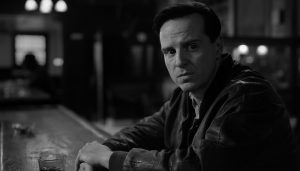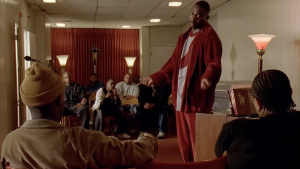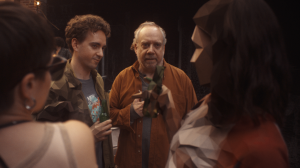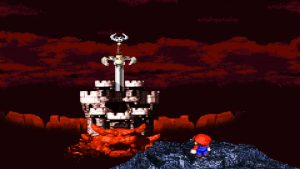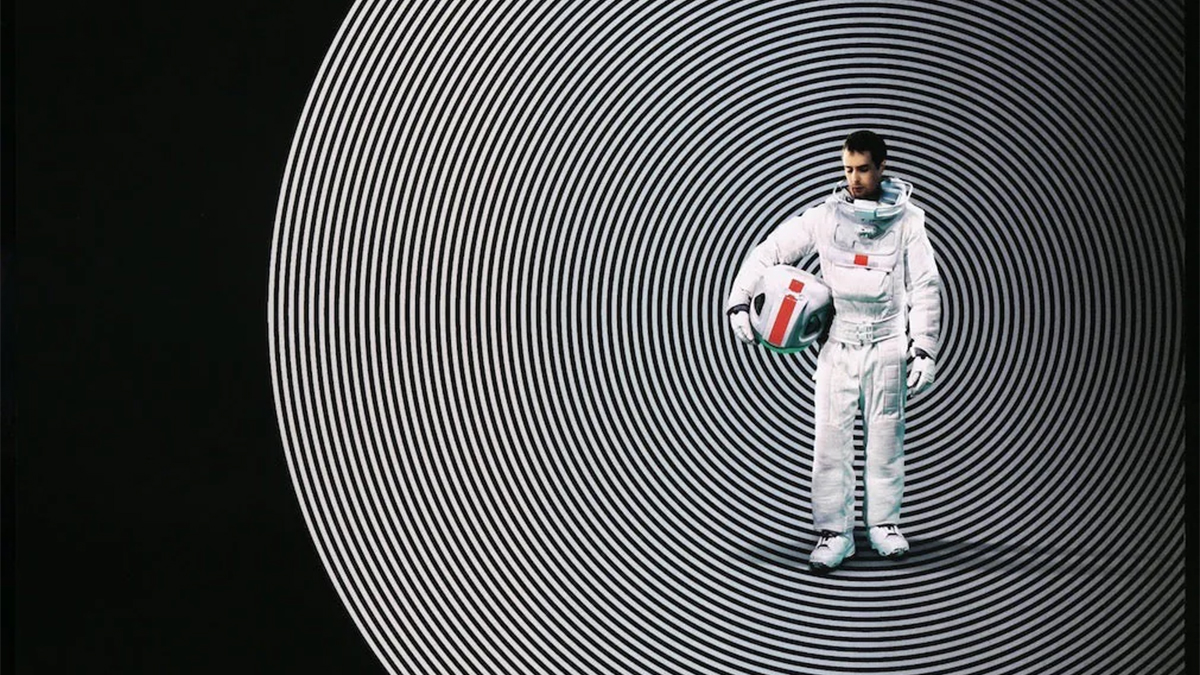
Waning: contains spoilers for Deep Impact, Moon and Ex Machina.
We may be dropping out of the Golden Age of Prestige Television (1999 – 2023, RIP), but while we may mourn the slow decline of mega-budget peak TV, take comfort – there is beauty in lower-budget productions. You might think science fiction would be particularly hard hit by a reduction in the amount of money available for VFX, sets, models, and so on, but over the years there have been plenty of examples of extraordinary science fiction films and television series that have been produced on low (or lower than usual) budgets.
Lightning in a Bottle
One of the best known types of low budget TV episode is the “bottle episode.” Although the origin of the term is often credited to the producers of Star Trek, Original Series co-producer Robert H. Justman said they used the terms “planet shows” and “ship shows” to distinguish between the more expensive ‘Planet of Hats’ stories and the less expensive stories set on the Enterprise itself. Justman credited the term “bottle show” to Leslie Stevens, producer of The Outer Limits (1963-1965), suggesting it originated in the idea of “pulling an episode right out of a bottle like a genie.”
Whatever the origins of the term, the first five live action Star Trek series (TOS, TNG, DS9, VOY, ENT), which were all produced in eras when American television shows were required to pump out 20 or more episodes a year, featured numerous bottle shows. Like any type of Star Trek episode, some were better than others, but there are some truly great episodes among them, including “The Tholian Web” (TOS), “Clues (TNG), “Duet” (DS9), “Meld” (VOY), and “Shuttlepod One” (ENT). In each case, the low budget encouraged the writers to produce dialogue-heavy, character-driven stories that explored fascinating (and often dark) sides of our regular heroes; “Duet” and “Meld” deserve special mention there.
Bottle episodes are, of course, not confined to Star Trek. Just about every long-running show, in any genre, that was made in the US between the 1960s and the 2010s has done a bottle episode at some point. The need to keep the cast small, the sets minimal or restricted to standing sets, and the story character-driven is what makes some bottle episodes so successful. Aaron Sorkin summed it up when he described The West Wing’s (very well-received) budget-saving bottle episode “17 People” as “I wrote a play”.
There isn’t time or space here to list all the brilliant science fiction bottle episodes made over that period of sixty years, but we will just quickly call attention to two notable examples. Dan Harmon’s postmodern sitcom Community is well known for drawing attention to the idea of a bottle episode and outright talking about it in its own well-loved bottle episode “Cooperative Calligraphy” – though that episode is not, of course, science fiction (unless you count the actions of the monkey).
However, Community did very occasionally make episodes that strayed into outright science fiction territory, the two main examples being “Epidemiology” and a bottle episode that is even better than “Cooperative Calligraphy” – “Remedial Chaos Theory”. It’s true that this could be interpreted as all taking place in Abed’s mind, but this episode plays like a genuine science fiction story about how an evening goes drastically differently in different parallel universes, depending on who goes to the door to get the pizza. It is one of the funniest episodes in a very funny show, it is a great exploration of the six main characters, and it gifted the internet with one of the most popular GIF reactions of all time. It is genius.
The other science fiction bottle episode that had a far greater impact than originally intended was Farscape’s “Crackers Don’t Matter”. Farscape was, overall, a very expensive show, which led to its eventual cancellation in favour of the very slightly cheaper Stargate SG-1. But it was also a show set on a (living) spaceship, so it could occasionally save the producers a little bit of money by doing a “ship show.” In this case, a visiting engineer persuades the crew to fly too close to some pulsars, whose intense light causes them to experience mental breakdowns. The title refers to the increasingly violent arguments some of the crew have over a large number of crackers they have on board.
Over the course of the episode, lead character John Crichton (Ben Browder) is in some ways less affected than the others, but seems to be severely affected in different ways. As well as being extremely aggressive to the point of nearly assaulting Chiana (Gigi Edgley), he starts hallucinating the series’ main villain, Scorpius (Wayne Pygram) in a Hawaiian shirt. At the time, this was intended to be a one-off for this episode, to allow Pygram’s Scorpius to appear in more episodes, and because it was funny. But a little bit later in the season, it was retconned into the first appearance of Harvey, a neural clone of Scorpius implanted in Crichton’s brain without his knowledge. Harvey’s existence and Crichton’s ongoing attempts to get rid of him would become key to the series’ overall arc and result in some major plot developments right up until the mini-series that was the show’s post-cancellation grand finale. And all because the team needed to save some money on this particular episode.
Movies That Make a Deeper Impact
Low-budget feature films can also be brilliant studies in tension and character drama, and often they are the feature film equivalent of bottle episodes – very small casts in a single location, with scripts that are dialogue-heavy and character driven. Two of the best examples of this paying off really well are Duncan Jones’ directorial debut Moon and Alex Garland’s directorial debut Ex Machina. (Notice a theme there? Most Hollywood directors have to make something impressive on a small budget before anyone will trust them with a bigger one).
Both films feature a very small number of characters trapped together in an isolated space. Bonus points to Moon for both onscreen characters being the same person (Sam Rockwell’s Sam Bell), accompanied only by some brief conversations on video calls and the voice of a computer (Kevin Spacey), as well as being trapped out in space on the literal moon, which makes Ex Machina’s four characters in a big house on a mountain look positively crowded. Both films put hard science fiction questions front and centre, with Ex Machina taking a deep dive into the workings of the Turing Test and Moon based around the idea of capitalist exploitations of cloning technology. Both are also pretty downbeat (be afraid of both AI and big corporations!) but that is not necessarily an indicator of their quality, though it is fair to say both with stay with you long after watching. And both benefit from their budgetary limitations. They are focused to the point of uncomfortable intensity, feature stellar performances from all the actors involved, and use their minimal special effects sparingly but oh so effectively.
Even a comparatively lower budget on a bigger film can result in increased quality. 1998 famously saw two movies about people trying to stop asteroids from hitting the Earth come out within months of each other – Armageddon, directed by Michael Bay with a budget of $140 million, and Deep Impact, directed by Mimi Leder with a big but lowER budget of $80 million. Armageddon topped the box office and made more money, but Deep Impact was itself the sixth highest grossing movie of the year and made plenty of money back from its budget, and arguably it was also the better film.
Armageddon is a typical Michael Bay movie, focused on spectacle at the expense of – well, really anything else. Deep Impact, on the other hand, is one of the most scientifically accurate science fiction movies ever made. Because of the budgetary constraints, Deep Impact could not spend as much time on big visuals. As a result, even though the characters in the film are not all that memorable in themselves, the impact of the title, as a large piece of the asteroid hits Earth, is felt by the audience because they experience it mostly on ground level with the characters. This gives us memorable images like a woman and her father embracing on the beach as a huge tidal wave sweeps over them, a teenager and his new teen bride racing for safety with her baby brother in her arms, and astronauts video-calling their loved ones to say goodbye before sacrificing themselves to stop a bigger impact from following. These human moments, even in somewhat under-developed characters, are more meaningful than big explosions and expensive special effects.
Character > VFX
A similar effect can be seen in one of the most acclaimed and impactful pieces of low budget television ever made, which is technically science fiction, though it doesn’t feel like it when you’re watching it. Threads was a 112-minute made-for-television BBC film that aired in September 1984. It is a bleak and graphic imagining of Britain following the outbreak of nuclear war and a nuclear bomb landing on Sheffield. A film on a similar theme, The Day After, directed by Star Trek II: The Wrath of Khan’s Nicholas Meyer, had aired in America the year before and had famously caused then-President Ronald Reagan to rethink his policy on nuclear war. Both are rightly acclaimed and very similar in many ways, but Threads is lower budget, and somehow even bleaker than the already bleak The Day After.
Written by Kes author Barry Hines, Threads covers a period of about 13 years from the outbreak of World War Three and the detonation of the nuclear bombs, and the low budget is part of what helps it to feel so real and so grounded. There is no need for a huge special effects budget showing dramatic shots of bombs going off and if we had seen that, it would detract from the intense experience of following everything from the point of view of the characters on the ground. We see what they see; the bombs go off at a distance, or above them as they cower in a basement, or they envelop them in flames then and there. Experiencing the attack that way, as you would in real life, is so much more horrifying than a big aerial special effects shot of a bomb going off. The story then follows the world as it descends into a sub-medieval state poisoned by radiation, and there is no need for a big budget as it follows increasingly desperate characters in terrifyingly ordinary situations.
Red Dwarf and Doctor Who: Highs and Lows
Particularly when it comes to BBC series, entire science fiction shows have been produced on low budgets. The first two series of Red Dwarf may be generally considered a bit weaker than series III-VI (though stronger than anything from series VII-XII), largely because of the later re-introduction and development of Kryten’s character, but there is a certain charm to the ultra-low-budget nature of series I and II. In these opening episodes, the radiation has yet to be cleared from the mining ship Red Dwarf’s officers’ quarters, so technicians Lister (Craig Charles) and Rimmer (Chris Barrie) continue to live in their own basic, lowest level bunks, and most of the stories focus intensely on the hilariously awkward pairing of these two characters, plus varying levels of attention paid to Holly (Norman Lovett) and the Cat (Danny John-Jules). These characters are trapped in a bleak environment with no one to talk to but each other, and the minimal sets and even more minimal visual effects reinforce that.
King of the low budget TV shows for most of its run, though, is of course Doctor Who. Sometimes, this was definitely a bad thing. Some of the classic serials aimed high but did not take the low budget into account in the writing, or the costume department got over-enthusiastic considering the means available to them. But for many years the revived show took the low budget into account when writing. There were still moments where the lack of finances definitely had an unfortunate effect, like the attack of the wheelie bin in series one’s “Rose”, or the iffy CGI on Mark Gatiss’ Professor Richard Lazarus in his monster form in series three’s “The Lazarus Experiment”. But when the writing took into account the limitations of the budget, some episodes of absolute genius were produced.
“Midnight“, for example, is superb bottle episode that uses the skills of the writer (Russell T Davies) and actors (especially David Tennant as the Tenth Doctor and Lesley Sharp as Sky Silvestri) to create one of the most tense episodes of the 60-year-old show with barely any special effects at all. This is not restricted to the revived series either. The show’s third ever serial, aired in February 1964, was a bottle episode before the concept or term was coined, and equally brilliant. “The Edge of Destruction” is a short serial set entirely on the TARDIS and featuring only the main cast. Like “Midnight”, the serial was surprising for the dark places to which it took the characters; the BBC Programme Board complained about a scene in which teenager Susan (Carol Ann Ford) threatens her teacher Ian (William Russell) with scissors, which violated the television codes of the time. And like “Midnight”, it is an excellent story.
The new Season 1 of Doctor Who, while still considered “low budget” by new collaborator Disney’s standards, has a much bigger budget, but it is hard to say to what extent that has improved the show. On the one hand, it has made the shocking and affecting “Dot and Bubble” possible, which requires an enormous number of VFX scenes plus a convincingly scary monster, and the increased budget resulted in some wonderful monster transformation scenes in “Rogue“. But on the other hand, some of the most tense and engaging episodes were “Boom”, which although it requires some VFX for the “ambulances” is almost a bottle episode as it takes place largely in one location with a small guest cast, and “73 Yards“, which features very little in the way of special effects at all, the main expenses being location shooting and guest actors.
Of course, we’re not saying there is anything inherently wrong with big budget science fiction. As long as the story is the first focus, throwing a decent budget at a project can create beautiful, captivating films like WALL-E, Avatar, or Avengers: Endgame, which could never be made to a high quality on a lower budget.
But when the writers and filmmakers, from costumes and props to VFX, take the budget into account in the production of the film or TV show, low budgets can produce something really rather special. There’s room for everything on our screens, and it would be a boring world if every film or show was the same. So let’s celebrate some of the really exciting, fascinating stories that can be told on a low budget, and never make the mistake of assuming that a big budget is always automatically better.
The post The Beauty of Low(er) Budget Sci-Fi appeared first on Den of Geek.
